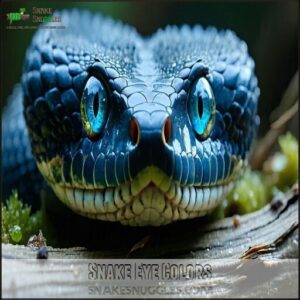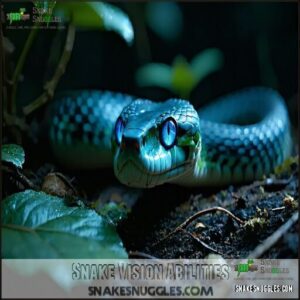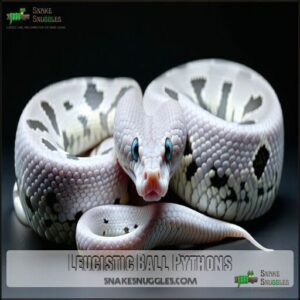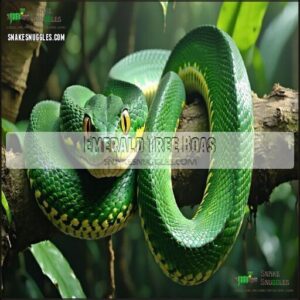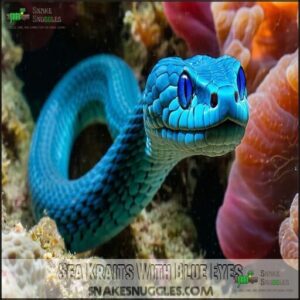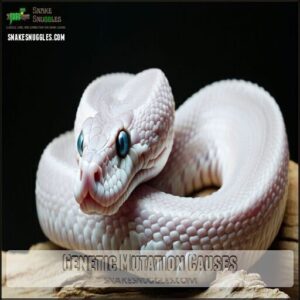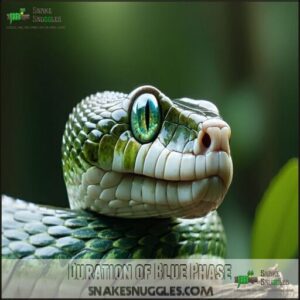This site is supported by our readers. We may earn a commission, at no cost to you, if you purchase through links.
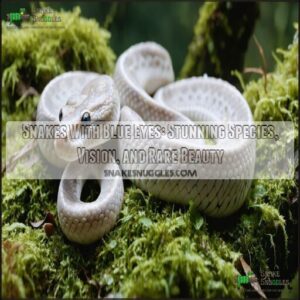
However, you’ve probably noticed most snakes temporarily display blue eyes during shedding—this "blue phase" occurs when fluid builds up between old and new eye caps, creating that cloudy blue appearance.
The blue typically lasts 1-2 days before shedding completes, and blue eyes result from specific genetic mutations affecting pigmentation.
While rare as a permanent feature, the contrast between a snake’s piercing blue gaze and its scaly body creates one of nature’s most striking visual puzzles, revealing unexpected nuances in reptilian genetics.
Table Of Contents
- Key Takeaways
- Snake Eye Colors
- Snake Vision Abilities
- Blue Eyed Snake Species
- Snake Shedding Process
- Conservation of Blue Eyed Snakes
- Frequently Asked Questions (FAQs)
- What snakes have blue eyes?
- Do blue eyed snakes have olfaction?
- What color are Snake Eyes?
- Do leucistic snakes have blue eyes?
- Why do snakes have blue eyes?
- Can blue-eyed snakes see in the dark?
- What kind of snakes have blue eyes?
- Are blue eyed snakes rare?
- Do garter snakes have blue eyes?
- Do snakes have eyes?
- Conclusion
Key Takeaways
- You’ll rarely find permanent blue eyes in snakes – they appear in less than 1% of species, with leucistic ball pythons being the most notable example due to specific genetic mutations affecting pigmentation.
- When your snake’s eyes turn cloudy blue, it’s entering the shedding process – this temporary "blue phase" lasts 3-5 days as fluid builds up between old and new eye caps before the skin is shed.
- Don’t mistake a snake’s blue eyes for its primary sensing tool – snakes rely more on their Jacobson’s organ for smell detection and pit organs for infrared sensing than on their limited vision.
- You can help your blue-eyed snake through shedding by maintaining proper humidity levels, which prevents complications like retained eye caps and ensures the smooth completion of this natural process.
Snake Eye Colors
Snake eye colors are fascinating, ranging from deep browns to rare shades like icy blue. These variations depend on pigments, iris structure, and genetic traits unique to different species.
Nature’s artistry in miniature—every snake’s eyes tell a story of adaptation, survival, and stunning genetic diversity.
Blue Eye Rarity
A snake’s blue eyes are like rare jewels in the reptile world, appearing in less than 1% of species.
A snake’s blue eyes are like rare jewels in the reptile world, appearing in less than 1% of species.
This blue eye rarity stems from fascinating genetic bottlenecks and unique breeding challenges. Here’s what makes blue eyed snakes so extraordinary:
- Limited species: Only a handful showcase this trait, such as leucistic ball pythons.
- Trait inheritance: Blue eyes result from rare mutations disrupting pigment production.
- Morph popularity: Selective breeding preserves these stunning traits.
These rare snake species showcase nature’s creative flair, with blue eyes mesmerizing enthusiasts and reminding us of the incredible diversity found in snake genetics blue.
The BELs are produced through specific morph breeding.
Pigments Responsible for Color
Have you ever noticed how some snakes have mesmerizing blue eyes?
It’s all thanks to chromatophore types and molecular interactions. These cells manage light reflection and adjust colors through genetic interruptions in iris pigmentation.
Surprisingly, snakes don’t use pigments like blue paint; instead, their color production relies on the way light bounces off iridophores.
When snake genetics disrupt pigment balance, rare genetic mutations reveal stunning blue hues.
This intricate process showcases the incredible complexity of snake eye pigmentation and snake coloration.
Interaction With Iris Structure
Beneath their mysterious gaze, the alluring blue eyes of snakes result from remarkable **interactions within the iris structure.
This process combines light refraction, precise pigment distribution, and unique iris cell arrangements** to create a dazzling optical effect.
One fascinating detail? Structural anomalies in the iris interact with pigments and genetic influences to scatter light in a way that amplifies the blue hue.
- Fun Fact: The transparent ocular scales over a snake’s eyes act like lenses, further enhancing this optical brilliance.
These rare features remind us how nature weaves complexity and beauty into the genetics of blue eyed snakes, turning their vision into a stunning phenomenon of diversity and adaptation.
Relation to Species and Activity
Eye color in snakes isn’t just for looks—it reflects fascinating adaptations tied to survival.
Blue-eyed snakes reveal unique species behavior and activity patterns. Nocturnal and diurnal variations play a big role here.
Nocturnal blue-eyed snakes often rely on camouflage purposes, hiding in shadows or under dense foliage. In contrast, diurnal species climb trees, scanning for prey in sunlit environments.
These snake species have specialized hunting strategies, blending their snake eye adaptations with sharp senses of smell and heat detection.
Whether scaling canopy tops or gliding through desert sands, their vision complements these behaviors. Subtle differences in snake eye colors highlight their snake behavior, showing how nature fine-tunes each species to thrive in its unique habitat.
Snake Vision Abilities
You might think snakes rely on their eyes, but their vision is actually limited, especially at night.
Instead, they depend on infrared sensing, vibrations, and their powerful sense of smell to navigate and hunt effectively.
Limited Night Vision
Blue eyes and other fascinating traits in snakes often highlight their unique evolutionary origins.
When it gets dark, nocturnal snakes don’t depend much on sight, as their limited night vision isn’t their strongest asset.
Instead, they lean on nocturnal adaptations like motion detection and faint-light sensitivity.
Their light sensitivity allows them to notice even slight movements in dim conditions, although clarity isn’t their focus.
With sensory compensation, they pair weaker vision with sharper tools like smell and vibration detection.
These hunting strategies make them incredible hunters, proving that even with restricted snake vision abilities, they’re masters at surviving the night.
Infrared Vision in Snakes
Snakes have an impressive infrared vision system that turns the darkness into a thermal playground.
Their specialized pit organs work like heat detectors, picking up even the faintest warmth from prey.
This advanced thermal imaging lets snakes locate predators or prey with pinpoint accuracy, especially during nocturnal hunting.
A world invisible to most becomes a vivid thermal map, showcasing their unmatched heat detection abilities.
It’s like carrying nature’s best night-vision goggles, always ready to hunt!
Sense of Smell Importance
If infrared vision is a snake’s thermal map, its sense of smell is its compass, guiding every move.
Snakes rely on their Jacobson’s organ to decode chemical signals in real-time, enabling prey detection, environmental analysis, and predator avoidance.
- Scent Tracking: Tongue flicks collect chemical cues, turning faint trails into vivid maps.
Snake repellents exploit this olfaction superpower to disrupt perception, protecting spaces from unwanted slithering visitors.
Role of Jacobson’s Organ
While snakes don’t rely heavily on vision, they’ve developed remarkable adaptations for survival.
The Jacobson’s organ functions as their sensory superpower. When a snake flicks its forked tongue, it’s collecting scent particles from the environment. These chemical cues are then inserted into this specialized organ located in the roof of the mouth.
Through scent particle analysis, blue-eyed snakes can detect prey from impressive distances. With each tongue flick, they’re mapping their surroundings through chemical signatures. This environmental awareness compensates for their limited sight, allowing precise prey tracking even in complete darkness.
The Jacobson’s organ is a chemosensory part of the olfactory system, and it basically transforms molecules into mental maps—turning chemical whispers into survival intelligence. The organ’s ability to analyze scent particles enables snakes to track prey with precise prey tracking, and its role in the olfactory system is crucial for their survival. The Jacobson’s organ is a key component of this system, and its function is essential for snakes to navigate their environment.
Blue Eyed Snake Species
You’ll discover that less than 1% of snake species naturally exhibit blue eyes, with leucistic ball pythons being the most popular example of this genetic rarity.
These striking blue-eyed snakes result from specific genetic mutations that interrupt normal pigment production, creating stunning specimens like the completely white Blue-eyed Leucistic ball python with its distinctive icy blue gaze.
Leucistic Ball Pythons
Leucistic ball pythons are a fascinating example of nature’s genetic artistry.
Their snow-white scales and icy blue eyes are the result of recessive leucism genetics, achieved through painstaking breeding combinations of Mojave, Lesser, Butter, and Russo ball pythons.
These designer snakes are among the most coveted blue-eyed snake morphs in the reptile world.
Breeders carefully blend python morphs to create this stunning variety, known for both its rarity and beauty.
Their popularity stems not just from their appearance but also their manageable care requirements, making them ideal for enthusiasts.
A range of products cater to leucistic ball python enthusiasts.
- **Imagine a pure white snake with piercing crystal-blue eyes gliding gracefully—it’s a living masterpiece of genetic innovation and reptilian charm.
Emerald Tree Boas
Many enthusiasts misidentify emerald tree boas as blue-eyed snake species when they actually possess striking yellow eyes with vertical pupils.
Their arboreal hunters dominate South American rainforest canopies with their bright green bodies and distinctive white zigzag patterns.
Their habitat specifics include high branches where they’ve developed specialized arboreal adaptations.
You’ll find their diet composition consists primarily of birds, bats, and small mammals, which they locate using specialized heat-sensing labial pits even in complete darkness.
Despite their formidable appearance, their temperament allows for captive care by experienced handlers under proper conditions.
Sea Kraits With Blue Eyes
While emerald tree boas dazzle in the canopy, the Blue-Lipped Sea Krait offers a different kind of beauty beneath the waves.
These stunning blue-eyed snakes seamlessly navigate between ocean and land with remarkable adaptations.
The blue-eyed sea kraits feature several fascinating characteristics:
- Their blue eyes match their distinctive blue-scaled lips
- Despite their potent venom, they’re typically non-aggressive
- They hunt fish among coral reefs using scent rather than heat detection
- Conservation status is currently "Least Concern," though they face habitat threats
Genetic Mutation Causes
Moving from the ocean’s blue-eyed sea kraits, we find that the stunning blue eyes of certain snakes actually stem from specific genetic mutations.
The BEL complex genes create these remarkable features when certain combinations occur. When breeders pair Mojave with Lesser genes, they produce completely white snakes with piercing blue eyes.
- Unlike albinism (which causes red eyes), leucism interrupts pigment production while preserving blue hues through unique chromatophore roles.
These genetic variations aren’t just beautiful—they’re scientific marvels. In some species, mutations in the mitf gene affect iris structure and genetic coding, creating those mesmerizing blue eyes you’ll see in leucistic ball pythons.
Snake Shedding Process
You’ll notice your snake’s eyes turn a cloudy blue color when fluid builds up between old and new skin layers during the shedding process.
This temporary blue phase lasts 3-5 days before the snake completes its molt, after which the eyes return to their normal appearance, marking the end of the shedding process.
Blue Eyes During Shedding
While examining blue-eyed snake species, you’ll notice another fascinating occurrence – all snakes’ eyes turn blue during shedding.
When a snake prepares to molt, fluid builds up between the old and new skin layers, creating a milky blue appearance over their ocular scales. This temporary transformation serves an important biological function.
| Phase | Duration | Vision Impact |
|---|---|---|
| Blue Phase | 3-5 days | Blurry vision |
| Shedding | 48 hours later | Limited vision |
| Recovery | 1-2 days | Normal vision returns |
Snake shedding frequency varies by age, with younger snakes molting more often. During this blue-eyed period, your snake may seem more reserved as vision blur affects their behavior. Proper humidity effects can help guarantee a smooth shedding process, preventing complications like retained eye caps.
Fluid Buildup Under Scales
The lubricating fluid that accumulates between a snake’s old and new skin creates that distinctive blue-eyed appearance during shedding.
This natural process aids scale separation and protects delicate ocular scales.
- Snakes experience temporarily blurry vision as fluid builds up under scales
- The blue coloration signals your snake’s healthy molting cycle is underway
- This biological mechanism evolved over millions of years for efficient skin renewal
Snake shedding frequency varies by species, but the blue eye phenomenon remains consistent across all serpents.
Duration of Blue Phase
During shedding, your snake experiences a distinctive blue phase lasting 3-5 days. This temporary period occurs when fluid accumulates between old and new skin layers, creating that cloudy blue appearance. Vision impairment during this time serves as natural protection for your reptile.
Snakes require regulated moisture guarantees for healthy shedding, so humidity is key.
| Stage | Duration | Characteristics |
|---|---|---|
| Pre-Blue | 1-2 days | Dull scales, slight cloudiness |
| Blue Phase | 3-5 days | Cloudy blue eyes, reduced activity |
| Shedding | 24-48 hours | Increased humidity needs, restlessness |
| Complete Shed | 1 day | Skin removal, restored vision |
| Post-Shed | Immediate | Clear eyes, increased activity |
Shedding frequency varies with age—younger snakes shed monthly while adults shed quarterly. Proper humidity impacts successful shedding and prevents retained eye caps.
Return to Normal Color
After the dramatic blue phase ends, how quickly do your snake’s eyes return to normal color? The transformation happens as part of the natural shedding cycle.
During post-shed clarity, you’ll notice:
- The milky fluid between ocular scales gradually disappears within 24-48 hours
- Eye caps detach completely with proper humidity influence
- Natural eye color re-emerges as bluish tint fades
- Vision sharpens, allowing your snake to resume normal hunting behaviors
Shedding frequency determines how often this fascinating process repeats.
Conservation of Blue Eyed Snakes
You’ll find that blue-eyed snakes face serious threats from habitat destruction and illegal wildlife trading, making conservation efforts essential for their survival.
Their genetic uniqueness and rarity in nature’s blueprint highlight why protecting these species through habitat restoration and specialized breeding programs is essential for maintaining biodiversity.
Habitat and Behavior
While snakes shed their skin, their survival depends on specific habitats.
Blue-eyed snakes inhabit diverse environments from lowland forests to grasslands. You’ll find them using microhabitats strategically for hunting and shelter.
Their daily activity patterns and territory size vary by species. The blue racer, a snake known for its distinctive blue coloration, favors grasslands and edge habitats.
| Habitat Type | Snake Behavior Adaptations |
|---|---|
| Forest Edge | Quick darting movements for ambush hunting |
| Grasslands | Temperature-regulated hunting strategies |
| Rocky Areas | Utilizes crevices for environmental adaptations |
| Mixed Habitats | Shows complex social interactions with other species |
Rarity and Conservation Status
Blue-eyed leucistic ball pythons stand out as some of the rarest snake morphs, fetching premium prices among collectors.
Their genetic diversity makes conservation particularly important.
You’ll find several blue-eyed species facing serious population threats – Eastern indigo snakes are protected under the U.S. Endangered Species Act, while blue racers are endangered in Canada.
Conservation challenges include habitat fragmentation and illegal trade.
Wildlife organizations have stepped up with breeding programs and habitat restoration efforts to preserve these stunning creatures.
Without these interventions, these remarkable snakes could disappear from our natural world entirely.
Threats to Blue Eyed Snakes
While populations of blue-eyed snakes dwindle, their survival faces mounting challenges.
Habitat loss shrinks their natural environments daily, while the illegal trade transforms these stunning creatures into high-priced collectibles.
Climate change further destabilizes their ecosystems, and poaching impacts remaining populations.
Conservation efforts focus on preserving genetic diversity, but these unique reptiles remain vulnerable.
Zoonotic diseases are also a concern for those handling these snakes.
Without coordinated protection addressing these threats, we risk losing these remarkable snakes forever, which would be a loss of biodiversity.
Safe Observation and Handling
When observing blue-eyed serpents, maintaining a respectful distance is your first priority. Expert guidance is essential before attempting any handling, as these rare creatures require special care to minimize stress.
Always use proper handling tools like snake hooks and transparent viewing containers when necessary.
- Practice good hygiene practices by washing hands before and after any potential contact to protect both you and the snake’s delicate eye health.
Never handle unfamiliar species without supervision, as improper techniques can lead to snake bites and harm to the animal. Safe observation and handling techniques preserve these magnificent creatures while allowing you to appreciate their unique beauty from a safe distance.
Frequently Asked Questions (FAQs)
What snakes have blue eyes?
In the blink of an eye, you’ll find blue-eyed leucistic ball pythons, emerald tree boas, sea kraits, and corn snake morphs like Palmetto and Ultramel Anery varieties displaying this striking feature during their lives.
This sentence is already a complete concept and does not require further separation.
Do blue eyed snakes have olfaction?
Yes, all snakes with blue eyes possess olfaction.
You’ll find they rely heavily on their sense of smell, using their Jacobson’s organ to interpret chemical particles rather than depending on their limited vision.
What color are Snake Eyes?
Snake eyes vary widely in color – browns, reds, greens, blacks, and even blues.
They’ll change during shedding, turning cloudy blue temporarily.
Most snakes have round pupils, while some venomous species have vertical slits.
Do leucistic snakes have blue eyes?
Most leucistic snakes do have striking blue eyes.
You’ll notice this distinctive feature especially in leucistic ball pythons, where their completely white bodies contrast dramatically with icy blue irises due to their genetic mutation.
Why do snakes have blue eyes?
You’ll notice blue eyes in snakes during their shedding process.
This temporary color change happens when fluid builds up between old and new skin layers, creating a cloudy blue appearance that lasts 3-5 days.
Can blue-eyed snakes see in the dark?
Like most snakes, blue-eyed varieties can’t see well in darkness. They rely primarily on their heat-sensing pits and excellent smell through their Jacobson’s organ to navigate and hunt at night.
What kind of snakes have blue eyes?
Blue-eyed leucistic ball pythons showcase stunning icy blue eyes due to genetic mutations.
You’ll also find blue eyes in certain morphs of reticulated pythons, Burmese pythons, emerald tree boas, and sea kraits.
Are blue eyed snakes rare?
Like diamonds in the rough, blue-eyed snakes are exceptionally rare.
Less than 1% of snake species exhibit this striking feature, making them prized finds for enthusiasts.
Blue eyes typically result from specific genetic mutations.
Do garter snakes have blue eyes?
Garter snakes don’t naturally have blue eyes.
You’ll typically observe their eyes as black or dark brown.
They only display bluish eyes temporarily during shedding when fluid builds up between old and new skin layers.
Do snakes have eyes?
Yes, snakes do have eyes.
They’re equipped with specialized visual organs, though they rely more on smell and vibration sensing.
Their eyes lack eyelids, instead being protected by transparent scales.
Conclusion
Whether you’re fascinated by the incredibly rare permanent blue eyes in leucistic ball pythons or just curious about that mysterious blue phase during shedding, snakes with blue eyes represent nature’s remarkable genetic diversity.
You’ll never look at these reptiles the same way once you understand the fluid buildup mechanics and structural adaptations behind their mesmerizing gaze.
Remember, most blue-eyed appearances are temporary, but they provide valuable insight into snake health and their upcoming shed cycle.
- https://www.abc.net.au/news/2022-02-18/rare-blue-tree-snake-popular-on-the-fraser-coast/100830322
- https://myfwc.com/wildlifehabitats/profiles/reptiles/snakes/eastern-indigo-snake/
- https://academic.oup.com/mbe/article/33/10/2765/2925616
- https://www.nature.com/articles/srep17118
- https://www.sciencedirect.com/science/article/pii/S1874391917302361?via%3Dihub

